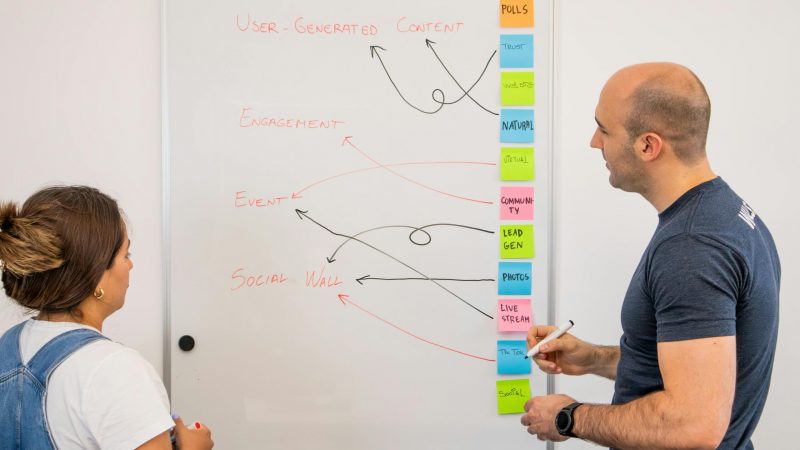Unlocking Growth: Supercharge Your Lead Generation
Want more high-quality B2B leads? This listicle delivers nine proven B2B lead generation strategies to boost conversions and achieve your business goals. Learn how to implement tactics like content marketing, LinkedIn social selling, account-based marketing (ABM), cold email outreach, webinars, referral programs, SEO, PPC advertising, and SDR programs.
Whether you’re a startup or an established enterprise, these B2B lead generation strategies provide a roadmap for maximizing your lead generation efforts and driving growth.
1. Content Marketing & Thought Leadership
Content marketing and thought leadership represent a cornerstone of successful B2B lead generation. It’s a strategic approach focused on creating and distributing valuable, relevant content to attract and engage your target business audience.
Instead of interrupting potential customers with disruptive advertising, you’re providing them with helpful resources that address their pain points and position your company as a trusted advisor. This strategy involves publishing various forms of content, including educational blogs, insightful whitepapers, compelling case studies, and in-depth research reports, all designed to showcase your expertise and generate leads organically.
Content marketing works by attracting your ideal customers through providing value. When you consistently create high-quality content that resonates with your target audience, they begin to see you as a credible source of information and a leader in your industry. This builds trust and fosters a relationship that extends beyond a single transaction.
As prospects engage with your content, they move through the sales funnel, eventually converting into qualified leads. Effective content marketing isn’t about aggressive selling; it’s about educating, informing, and building relationships.
This approach offers a multitude of features beneficial for lead generation. These include the creation of educational and informative content, SEO optimization to ensure organic discoverability, diverse content formats such as blogs, videos, podcasts, and infographics, strategic use of lead magnets and gated content, and a consistent publishing schedule to maintain engagement.
This method deserves a top spot in any B2B lead generation strategy list because it’s a sustainable, long-term approach that delivers compounding returns. Unlike paid advertising, which stops generating leads the moment you stop spending, content marketing continues to attract prospects organically over time.
Pros of Content Marketing & Thought Leadership:
- Builds long-term brand authority and trust: By consistently delivering valuable insights, you establish your company as a thought leader and build credibility within your industry.
- Cost-effective compared to paid advertising: While requiring an investment of time and resources, content marketing often proves more cost-effective in the long run than ongoing paid campaigns.
- Generates organic traffic and leads: By optimizing content for search engines, you attract potential customers actively searching for solutions you offer.
- Nurtures prospects throughout the buying journey: Content can be tailored to address the needs of prospects at different stages, guiding them towards a purchase decision.
- Improves search engine rankings: High-quality, SEO-optimized content boosts your website’s visibility in search results, driving more organic traffic.
Cons of Content Marketing & Thought Leadership:
- Requires significant time investment: Creating high-quality content requires research, writing, editing, and promotion, demanding a considerable time commitment.
- Results take months to materialize: Building organic traffic and establishing thought leadership takes time and patience; don’t expect immediate results.
- Demands consistent content production: To maintain engagement and momentum, a regular publishing schedule is essential.
- Difficult to measure direct ROI: While various metrics can track content performance, directly correlating content to revenue can be challenging.
- Requires subject matter expertise: Creating authoritative content necessitates a deep understanding of your industry and the challenges faced by your target audience.
Examples of Successful Implementation:
- HubSpot: Their comprehensive marketing blog and academy provide a wealth of resources for marketers, establishing HubSpot as a leading authority in inbound marketing.
- Salesforce: The Trailhead learning platform offers interactive modules and certifications, empowering users and building brand loyalty.
- IBM: Their thought leadership reports and research showcase their expertise in technology and business solutions.
- Mailchimp: Their marketing guides and resources provide practical advice for small businesses, building trust and driving user adoption.
Actionable Tips for B2B Lead Generation:
- Focus on solving specific problems your prospects face: Address their pain points and offer practical solutions.
- Use data and original research to create unique insights: Differentiate your content by providing valuable data and perspectives.
- Repurpose content across multiple channels: Maximize your reach by adapting your content for different platforms (e.g., blog posts into infographics or short videos).
- Include clear calls-to-action (CTAs) in all content: Guide your audience towards the next step, whether it’s downloading a resource, requesting a demo, or contacting your sales team.
- Track engagement metrics and lead conversion rates: Monitor the performance of your content and identify areas for improvement.
By following these tips and understanding the nuances of content marketing and thought leadership, B2B organizations can build a robust lead generation engine that delivers sustainable, long-term results. The key is to provide genuine value, establish trust, and position your company as a go-to resource for your target audience. This approach aligns perfectly with the needs of modern B2B companies, particularly SaaS companies, eCommerce brands, and startups seeking scalable and sustainable growth.
2. LinkedIn Social Selling
LinkedIn Social Selling is a powerful B2B lead generation strategy that focuses on building genuine relationships with potential customers within the LinkedIn ecosystem. Unlike traditional outbound sales tactics, social selling emphasizes nurturing prospects through personalized interactions, valuable content sharing, and active engagement, ultimately positioning yourself as a trusted advisor rather than a pushy salesperson.
This approach leverages LinkedIn’s extensive professional network to identify, connect with, and build rapport with key decision-makers and stakeholders, leading to warmer leads and higher conversion rates. It’s a crucial component of any comprehensive b2b lead generation strategies arsenal.
This strategy works by leveraging the power of personal branding and targeted networking. Instead of cold calling or sending generic emails, you connect with prospects on a human level, engaging with their content, participating in relevant group discussions, and sharing insightful information that addresses their pain points.
By consistently providing value and building trust, you establish yourself as a credible resource and increase the likelihood of converting prospects into paying customers. This method deserves a spot on any list of top b2b lead generation strategies due to its ability to generate highly qualified leads and foster long-term customer relationships.
LinkedIn Social Selling offers a range of features that facilitate effective prospect engagement. Advanced search and filtering capabilities within LinkedIn (and even more robustly within LinkedIn Sales Navigator) allow you to pinpoint ideal customer profiles based on industry, job title, company size, and other relevant criteria.
Personalized connection requests and messages enable you to tailor your outreach and establish a more personal connection. Content sharing and engagement features allow you to share valuable insights and position yourself as a thought leader. Social listening tools allow you to monitor industry conversations and identify potential prospects who are actively seeking solutions.
Several high-profile companies have demonstrated the effectiveness of LinkedIn Social Selling. Microsoft’s sales teams utilize Sales Navigator to identify and connect with key decision-makers in enterprise organizations, shortening sales cycles and closing larger deals. Salesforce account executives actively build and nurture industry networks on LinkedIn, positioning themselves as trusted advisors and generating a steady stream of qualified leads.
Adobe’s customer success managers leverage LinkedIn to engage with existing clients, fostering stronger relationships and driving customer retention. Even Zoom’s rapid growth can be attributed in part to their effective community building strategies on LinkedIn, solidifying their brand presence and reaching a wider audience.
While LinkedIn Social Selling offers numerous benefits, including access to decision-makers, higher response rates than cold email, and cost-effective networking, it’s essential to be aware of the potential drawbacks. Building meaningful relationships takes time and consistent effort. LinkedIn platform limitations and the cost of premium tools like Sales Navigator can be a barrier for some businesses.
There’s also the risk of appearing too salesy if not executed thoughtfully. Consistent daily activity is crucial for success, and the platform’s reach is inherently limited to the LinkedIn ecosystem.
To maximize your success with LinkedIn Social Selling, consider the following tips:
- Optimize your LinkedIn profile: Treat your profile as a landing page, showcasing your expertise and value proposition.
- Share valuable industry insights: Focus on providing helpful content, not just promoting your products or services.
- Engage with prospects’ content: Demonstrate genuine interest by commenting on and sharing their posts before reaching out directly.
- Use video messages: Personalized video messages can significantly increase engagement and connection rates.
- Track your metrics: Monitor connection acceptance rates, response metrics, and other key performance indicators to refine your approach.
Social selling pioneers like Jill Rowley, Jamie Shanks, Koka Sexton, and Matt Reynolds have championed this approach and demonstrated its effectiveness in generating B2B leads. Their work highlights the importance of building authentic relationships and leveraging LinkedIn’s powerful networking capabilities to drive business growth. By incorporating these principles into your B2B lead generation strategy, you can tap into a vast network of potential customers and build a sustainable pipeline of qualified leads. For B2B organizations, SaaS companies, and eCommerce brands, LinkedIn Social Selling offers a compelling alternative to traditional outbound methods and can be a key driver of growth and revenue.
3. Account-Based Marketing (ABM)
Account-Based Marketing (ABM) stands out as a powerful B2B lead generation strategy, particularly for businesses targeting high-value accounts. Unlike traditional marketing approaches that cast a wide net, ABM takes a laser-focused approach. It involves deep collaboration between sales and marketing teams to identify, target, and engage specific key accounts with personalized campaigns.
Essentially, ABM treats each high-value account as its own market, tailoring content and experiences to resonate with key decision-makers within those organizations. This targeted approach makes ABM a highly effective strategy for driving qualified leads and closing larger deals.
ABM works by first identifying and prioritizing target accounts based on factors like revenue potential, industry influence, and strategic fit. Once target accounts are identified, extensive research is conducted to understand their specific needs, challenges, and pain points. This research forms the basis for creating personalized content and messaging across multiple channels.
Coordinated campaigns are then launched, often involving a mix of digital advertising, email marketing, direct mail, and social media outreach. Throughout the process, close alignment between sales and marketing teams is critical to ensure a consistent and cohesive experience for the target accounts. Finally, rigorous tracking of account-specific metrics and ROI allows for continuous optimization and refinement of the ABM strategy.
One of the key features of successful ABM is the meticulous identification and prioritization of target accounts. This process often involves using firmographic data, technographic insights, and intent data to pinpoint the accounts that are most likely to convert into high-value customers.
- For example, Terminus, a leading ABM platform, helps businesses target Fortune 500 accounts with personalized campaigns, while Snowflake employs an enterprise ABM program specifically designed for data companies.
- Similarly, 6sense leverages AI-powered ABM to reach technology buyers, and Demandbase provides an account-based advertising platform.
These examples highlight how ABM is implemented across different sectors, targeting specific high-value accounts with tailored strategies.
While the benefits of ABM are significant, it’s important to acknowledge the potential drawbacks. Implementing ABM can be resource-intensive, requiring a dedicated team and significant investment in technology. It may not be as easily scalable as other lead generation strategies, and sales cycles can be longer. Furthermore, ABM relies heavily on high-quality data, making data accuracy crucial for success.
For businesses considering ABM as a B2B lead generation strategy, several actionable tips can help ensure successful implementation. Start with a small pilot program focusing on 10-20 key accounts. Invest in robust account intelligence and research tools to gather detailed information about target accounts.
Create account-specific content and dedicated landing pages that address the unique needs and pain points of each target account. Ensure close alignment between sales and marketing goals and metrics, fostering a collaborative approach. Leverage intent data to identify buying signals and tailor outreach accordingly.
ABM is particularly effective for B2B organizations seeking to improve lead acquisition and reduce churn, especially within the SaaS space, where high-value accounts are paramount. It’s also a valuable strategy for eCommerce brands looking to target specific business segments with personalized offerings.
Furthermore, ABM can be a powerful tool for venture capital-backed startups seeking rapid, scalable growth by focusing on acquiring key early adopters. For those looking for expert support in implementing ABM, partnering with a marketing team specializing in CRO, SEO, and performance marketing can be highly beneficial.
ABM offers several compelling advantages. It delivers higher conversion rates and larger deal sizes compared to traditional marketing approaches. ABM also strengthens sales and marketing alignment, fostering a more collaborative and efficient working relationship. It allows for more efficient resource allocation by focusing efforts on high-potential accounts. ABM also cultivates stronger customer relationships through personalized engagement.
Finally, it provides clearer ROI measurement, enabling businesses to track the effectiveness of their ABM efforts and make data-driven adjustments. Pioneered by thought leaders like Sangram Vajre (Terminus), Jon Miller (Demandbase), Kathy Macchi (Tele-Tech), and ITSMA, ABM has evolved into a crucial B2B lead generation strategy, empowering businesses to effectively target and engage high-value accounts for sustained growth.
4. Cold Email Outreach
Cold email outreach remains a potent B2B lead generation strategy, even in today’s crowded digital landscape. It’s a direct marketing approach where you send targeted, personalized email campaigns to prospects who haven’t previously interacted with your company. Unlike spam, effective cold email focuses on providing value, solving problems, and building relationships rather than pushing for an immediate sale.
Modern cold email leverages automation tools to achieve scale while maintaining a critical degree of personalization. This balance allows businesses to connect with a large number of potential customers efficiently while ensuring each interaction feels relevant and valuable. For B2B organizations focused on improving lead acquisition and reducing churn, cold email offers a direct line to decision-makers, making it a valuable tool in the lead generation arsenal.
This strategy thrives on meticulous targeting and personalization. It begins with building a highly targeted prospect list based on factors such as industry, company size, job title, and online behavior. This granular approach ensures your message reaches the individuals most likely to be interested in your product or service.
Once your target list is defined, you craft personalized email sequences that address the specific pain points and needs of each segment. These sequences are not about aggressive selling; instead, they focus on offering valuable insights, resources, or solutions related to the prospect’s industry or role.
Cold email outreach offers several key features that contribute to its effectiveness. These include targeted prospect list building based on ideal customer profiles, the development of personalized email sequences designed to nurture leads, A/B testing of subject lines and content to optimize campaign performance, email automation and scheduling for efficiency, and robust response tracking and follow-up sequences. This structured approach, combined with data-driven optimization, allows businesses to refine their campaigns and improve their lead generation results over time.
Several companies exemplify successful cold email outreach. Outreach.io, for instance, is known for its systematic approach to sales development, emphasizing consistent and personalized communication.
- Lemlist has carved a niche by integrating video personalization into cold emails, adding a human touch to the digital outreach process.
- Reply.io champions multi-channel outreach sequences, incorporating other platforms like LinkedIn and phone calls to create a more comprehensive and engaging experience.
- Mixmax focuses on advanced email tracking and automation, providing valuable insights into recipient behavior.
While powerful, cold email outreach is not without its challenges. Response rates are typically low, hovering between 1-5%. There’s always the risk of being marked as spam, especially if your targeting or messaging is off.
Compliance with regulations like CAN-SPAM and GDPR is crucial for maintaining a positive brand reputation and avoiding legal issues. Done poorly, cold emailing can damage your brand’s reputation and contribute to the growing problem of email fatigue among recipients.
To maximize the effectiveness of your cold email campaigns and mitigate potential risks, follow these tips: Research prospects thoroughly to ensure genuine personalization. Keep initial emails short and concise, ideally under 100 words.
Focus on the recipient’s challenges and how you can help solve them, rather than solely promoting your product. A/B test different subject lines and send times to identify what resonates best with your target audience. Finally, follow up consistently but respectfully, aiming for 5-7 touchpoints in your sequence.
The power of cold email outreach as a b2b lead generation strategy has been popularized by figures like Steli Efti of Close.com, Aaron Ross, known for his Predictable Revenue methodology, sales trainer Josh Braun, and Sam Blond, former Salesforce VP.
They have demonstrated how a strategic and personalized approach to cold emailing can generate significant leads and drive business growth. For SaaS companies aiming to accelerate subscription growth, eCommerce businesses seeking to optimize conversions, or venture-backed startups demanding rapid experimentation, cold email, when executed effectively, can be a valuable component of a comprehensive lead generation strategy.
5. Webinars and Virtual Events
Webinars and virtual events have become a cornerstone of successful B2B lead generation strategies, offering a dynamic platform to engage prospects, demonstrate expertise, and nurture leads.
These online presentations and events provide valuable insights to a targeted audience, fostering a sense of community and interaction that translates into high-quality leads. This approach combines thought leadership with a clear call to action, typically registration, making it a powerful tool for businesses seeking to expand their reach and drive growth.
How Webinars and Virtual Events Work for Lead Generation:
The core mechanism of webinars and virtual events for lead generation revolves around providing valuable content in exchange for contact information. Prospects register for the event, providing their name, email address, company, and sometimes other relevant data. This registration process acts as the initial lead capture, providing businesses with a qualified list of potential customers who have demonstrated a clear interest in the topic and, by extension, the company’s offerings.
During the event itself, interactive elements like live Q&A sessions, polls, and chat functionalities further engage attendees and provide valuable insights into their needs and pain points. This real-time interaction allows businesses to position themselves as thought leaders and build rapport with potential customers.
Following the event, recordings are often made available on-demand, extending the reach and providing further opportunities for lead capture. Finally, strategically crafted follow-up email sequences nurture these leads, providing additional resources, promoting relevant products or services, and ultimately guiding them through the sales funnel.
Examples of Successful Implementation:
Several companies have effectively leveraged webinars and virtual events for B2B lead generation:
- Zoom: Ironically, Zoom itself utilizes weekly product demonstrations and training sessions to showcase its platform’s capabilities and onboard new users, effectively turning product education into a lead generation engine.
- HubSpot: HubSpot’s marketing and sales certification webinars attract professionals eager to enhance their skills, providing HubSpot with a highly engaged audience and potential customers for their marketing automation software.
- Salesforce: Salesforce’s Trailhead Live training sessions provide in-depth instruction on their platform, generating leads and fostering a loyal community of users.
- Gartner: Gartner utilizes industry research presentations to share valuable insights and position themselves as thought leaders, attracting a high-quality audience of business decision-makers.
Actionable Tips for Successful Webinars and Virtual Events:
- Choose Relevant Topics: Focus on addressing specific pain points and challenges faced by your target audience. Don’t just pitch your product; offer valuable information that resonates with their needs.
- Promote Strategically: Leverage multiple channels like email marketing, social media, and paid advertising to promote your webinar 2-3 weeks in advance.
- Optimize Duration: Keep presentations concise and engaging, ideally within the 30-45 minute range, followed by a dedicated Q&A session.
- Follow Up Effectively: Implement automated email sequences to send reminders before the event and valuable follow-up content afterward.
- Offer Resources: Create downloadable resources like white papers, checklists, or templates to extend engagement and provide additional value.
Pros and Cons of Webinars and Virtual Events:
Pros:
- Generates high-quality leads with demonstrated interest.
- Positions your company as a thought leader in your industry.
- Allows for real-time engagement and interaction with potential customers.
- Content can be repurposed into other formats like blog posts and social media updates.
- Extends your global reach without incurring travel costs.
Cons:
- Requires significant preparation time and effort.
- Involves technical setup and the potential for technical issues.
- Attendance rates typically range between 40-50% of registrations.
- Scheduling can be challenging across different time zones.
- Faces competition from numerous other webinars and virtual events.
When and Why to Use Webinars and Virtual Events:
Webinars are particularly effective for B2B lead generation strategies when you aim to educate your target audience, build thought leadership, and generate qualified leads. They are ideal for demonstrating complex products or services, sharing industry insights, and fostering a sense of community.
Platforms like GoToWebinar, Zoom, WebEx, and ON24 have popularized and refined the webinar format, providing robust tools and features to facilitate successful events. By focusing on providing valuable content and engaging with attendees, webinars and virtual events can become a powerful engine for driving growth and achieving your B2B lead generation goals.
6. Referral and Partner Programs: Leverage the Power of Trust for B2B Lead Generation
Referral and partner programs represent a potent, relationship-driven approach to B2B lead generation strategies. This strategy leverages the inherent trust and influence within your existing customer base, partner networks, and professional connections to generate warm leads and qualified prospects.
Instead of casting a wide net with traditional outbound marketing, referral programs rely on targeted introductions and recommendations, making them a highly effective way to acquire new business. This approach capitalizes on the principle that a recommendation from a trusted source carries significantly more weight than any advertisement.
This strategy works by incentivizing existing customers, partners, and even industry peers to recommend your products or services to their network. This can be achieved through various mechanisms, such as formal referral programs with rewards, co-marketing initiatives with partners, or simply fostering a culture of advocacy amongst your existing customers.
The underlying premise is simple: people are more likely to consider a product or service when it’s recommended by someone they trust. This translates to higher conversion rates, lower customer acquisition costs, and ultimately, a more sustainable growth trajectory.
Several successful examples demonstrate the power of referral and partner programs as effective b2b lead generation strategies:
- Dropbox’s explosive growth: Dropbox’s referral program became legendary for its simplicity and effectiveness. By offering users extra storage space for referring new users, they fueled viral growth and quickly became a market leader in cloud storage.
- Slack’s integration partner ecosystem: Slack’s success is partially attributed to its robust partner ecosystem. By integrating with numerous other business applications, Slack embedded itself into existing workflows, creating a natural pathway for referrals and new user acquisition.
- HubSpot’s agency partner program: HubSpot’s agency partner program empowers marketing agencies to resell HubSpot’s software and services, creating a valuable network of trusted advisors who actively generate leads for HubSpot.
- Salesforce’s AppExchange marketplace: The Salesforce AppExchange is a prime example of a thriving partner ecosystem. By offering a platform for third-party developers to build and sell applications that integrate with Salesforce, they’ve created a vast network of partners who contribute to lead generation and customer acquisition.
Implementing a successful referral and partner program requires a strategic approach. Here are some actionable tips:
- Create clear and compelling incentive structures: Offer rewards that resonate with your target audience. This could be anything from discounts and free products to exclusive access or monetary bonuses. The key is to make the incentive valuable enough to motivate referrals.
- Simplify the referral process: Make it as easy as possible for people to refer your business. Provide pre-written email templates, referral links, and clear instructions to minimize friction.
- Engage regularly with partners: Nurture your partner relationships through regular communication, training, and support. This ensures they are equipped to effectively represent your brand and generate quality leads.
- Recognize and reward top referral sources: Publicly acknowledging and rewarding top referrers creates a sense of community and encourages continued participation.
- Implement referral tracking software: Accurate tracking and attribution are crucial for measuring the success of your program and identifying areas for improvement. Utilize dedicated referral software to streamline this process.
While referral and partner programs offer numerous advantages, it’s crucial to be aware of the potential challenges:
- Scalability: While powerful, these programs can be difficult to scale systematically, especially in the initial stages.
- Dependence: Relying heavily on partners can create dependencies and potential vulnerabilities if partner performance is inconsistent.
- Tracking complexity: Managing and tracking referrals across multiple partners and channels can be complex without the right tools and processes.
- Longer sales cycles: Partner-driven deals often have longer sales cycles compared to direct sales.
Despite these challenges, referral and partner programs are a worthwhile investment for most B2B organizations. The benefits of higher conversion rates, lower acquisition costs, and increased customer lifetime value far outweigh the potential drawbacks. By leveraging the power of trust and existing relationships, these programs can be a powerful engine for sustainable growth and a valuable component of any comprehensive B2B lead generation strategy.
They are particularly well-suited for businesses with an established customer base and strong network connections. For SaaS companies, eCommerce brands, B2B organizations, and startups seeking scalable growth, incorporating referral and partner programs can significantly impact lead acquisition and overall business success. If you’re looking to build a sustainable, cost-effective lead generation engine, leveraging the power of referrals is a strategy you can’t afford to ignore.
7. Search Engine Optimization (SEO) for B2B
Search Engine Optimization (SEO) for B2B is a powerful, long-term strategy designed to increase your website’s visibility in search engine results pages (SERPs). Unlike paid advertising, which delivers immediate but temporary traffic, SEO focuses on earning organic traffic – visitors who find your site through search engines like Google.
This strategy is particularly effective for B2B companies because it targets potential customers actively researching solutions, allowing you to connect with high-intent leads at the precise moment they’re looking for information.
B2B SEO differs from B2C SEO in several key ways. B2B buyers often have longer sales cycles and conduct more thorough research before making a purchase. Therefore, B2B SEO emphasizes in-depth, educational content that demonstrates expertise and builds trust.
Instead of targeting short, transactional keywords, B2B SEO focuses on longer, more specific search queries (long-tail keywords) that reflect the complex needs and challenges faced by businesses. For example, instead of targeting “CRM software,” a B2B company might target “best CRM software for small manufacturing businesses.”
This approach requires a multi-faceted strategy encompassing several core features:
- Keyword research and content optimization: Identifying relevant keywords that potential customers are using and strategically incorporating them into website content, meta descriptions, and title tags.
- Technical SEO and site structure: Ensuring your website is technically sound and easy for search engines to crawl and index. This includes optimizing site speed, mobile-friendliness, and URL structure.
- Local and industry-specific optimization: Tailoring your SEO strategy to target specific geographic areas or industry niches.
- Content cluster and pillar page strategies: Creating a network of interconnected content pieces around a central topic (pillar page) to establish topical authority and improve search rankings.
- Link building and domain authority development: Earning high-quality backlinks from reputable websites to signal trustworthiness and authority to search engines.
The benefits of implementing a robust B2B SEO strategy are numerous:
- Consistent, long-term organic traffic: Once established, SEO can provide a steady stream of targeted traffic without ongoing advertising costs.
- High-intent leads: SEO attracts users actively searching for solutions, making them more likely to convert into customers.
- Cost-effective once established: While initial setup and ongoing optimization require investment, SEO becomes increasingly cost-effective as your website climbs the rankings.
- Builds credibility and trust: Ranking high in search results establishes your brand as an authority in your industry, fostering trust and credibility among potential customers.
- Compounds over time: The efforts you invest in SEO accumulate, leading to greater visibility and traffic over time.
However, B2B SEO also presents some challenges:
- Takes time to see results: Unlike paid advertising, SEO is a long-term strategy that typically takes 6-12 months to produce significant results.
- Requires ongoing content creation and optimization: Staying ahead of the competition requires consistent creation of high-quality, optimized content.
- Algorithm changes can impact rankings: Search engine algorithms are constantly evolving, requiring ongoing adaptation and optimization.
- Competitive keywords are difficult to rank for: Ranking for highly competitive keywords requires significant effort and expertise.
- Technical expertise required: Implementing a successful SEO strategy often requires technical knowledge of website development, analytics, and SEO best practices.
Optimizing your website and content for search engines is crucial for driving organic traffic. A key part of any SEO strategy involves using analytics to track your SEO performance. This helps you understand what’s working, what’s not, and how to improve your approach.
Several industry leaders have popularized and shaped the field of SEO, including Rand Fishkin (Moz founder), Neil Patel (digital marketing expert), Brian Dean (Backlinko), and Aleyda Solis (international SEO consultant). Their insights and tools have helped countless businesses harness the power of SEO.
Companies like Moz, Ahrefs, SEMrush, and HubSpot offer valuable resources and tools to support your B2B SEO efforts.
To maximize your B2B SEO success, consider the following tips:
- Target long-tail keywords: Focus on specific, long-tail keywords that reflect the needs and challenges of your target audience.
- Create comprehensive pillar pages: Develop in-depth pillar pages on core topics to establish topical authority.
- Optimize for featured snippets and voice search: Adapt your content to target featured snippets and voice search queries.
- Build high-quality backlinks: Earn backlinks from authoritative websites through guest posting, partnerships, and other outreach efforts.
- Focus on user experience and page loading speed: Ensure your website provides a seamless and enjoyable user experience.
By embracing these strategies and continuously optimizing your approach, you can leverage the power of B2B SEO to drive sustainable growth and establish your brand as a leader in your industry.
8. Pay-Per-Click (PPC) Advertising
Pay-Per-Click (PPC) advertising is a powerful b2b lead generation strategy that allows businesses to display targeted ads to specific audiences across various platforms like Google Ads, LinkedIn Ads, and Microsoft Advertising.
By leveraging PPC, companies can achieve immediate visibility and generate leads by placing their message directly in front of potential customers actively searching for relevant products or services. This approach offers precise targeting based on demographics, interests, job titles, company size, industry, and even search intent, making it a highly effective tool for B2B lead generation.
PPC advertising works on a bidding system. Businesses bid on specific keywords related to their offerings. When a user searches for a keyword that a business is bidding on, the search engine platform runs an auction to determine which ads will be displayed.
Factors influencing ad placement include the bid amount, the quality score of the ad (a metric reflecting the relevance and quality of the ad and landing page), and the expected click-through rate. The higher the bid and quality score, the better the chances of securing a prominent ad position. When a user clicks on the ad, the business pays the agreed-upon bid amount. This “pay-per-click” model ensures that businesses only pay when their ads receive genuine interest.
Features of PPC Advertising for B2B Lead Generation:
- Keyword Bidding and Ad Placement: Effective keyword research and strategic bidding are crucial for successful PPC campaigns. Identifying relevant keywords that your target audience uses is essential for reaching the right prospects.
- Audience Targeting and Segmentation: PPC platforms offer advanced targeting options, enabling businesses to segment their audience based on various criteria, ensuring ads are displayed to the most qualified leads. This includes targeting by job title, industry, company size, and even specific interests or behaviors.
- Landing Page Optimization: Driving traffic to a dedicated landing page optimized for conversions is critical. The landing page should align seamlessly with the ad copy and offer a clear call to action, encouraging visitors to take the desired next step.
- Conversion Tracking and Attribution: Robust tracking mechanisms allow businesses to measure the effectiveness of their campaigns and attribute conversions back to specific ads and keywords. This data is invaluable for optimizing campaigns and maximizing ROI.
- A/B Testing of Ad Creative and Copy: Continuous A/B testing of different ad variations helps identify the most effective messaging and creative elements, leading to improved click-through rates and conversion rates.
Pros of PPC Advertising:
- Immediate Visibility and Traffic: PPC provides instant visibility on search engine results pages and social media platforms, driving targeted traffic to your website or landing pages.
- Precise Targeting Capabilities: The granular targeting options offered by PPC platforms allow businesses to reach highly specific B2B audiences, minimizing wasted ad spend.
- Measurable ROI and Performance Metrics: Detailed tracking and analytics provide clear insights into campaign performance, enabling businesses to measure ROI and make data-driven decisions.
- Flexible Budget Control: Businesses can set and adjust their daily or monthly budgets based on their needs and resources, offering flexibility and control over ad spend.
- Quick to Launch and Optimize: PPC campaigns can be set up relatively quickly and optimized continuously based on performance data, allowing for agile adjustments and improvements.
Cons of PPC Advertising:
- Can Be Expensive for Competitive Keywords: Highly competitive keywords can drive up bidding costs, making it challenging for businesses with limited budgets.
- Requires Ongoing Management and Optimization: Successful PPC campaigns require continuous monitoring, analysis, and optimization to maintain performance and maximize ROI.
- Costs Increase Over Time: As competition increases, bidding costs tend to rise, requiring businesses to adjust their budgets accordingly.
- Stops Generating Leads When Budget is Paused: Lead generation stops immediately when the budget is paused or depleted, requiring consistent funding for sustained results.
- Click Fraud and Invalid Traffic Risks: While platforms have measures in place to mitigate click fraud, there’s always a risk of invalid clicks that can deplete budgets without generating genuine leads.
Examples of B2B PPC Implementations:
- A B2B software company targeting “project management software for engineering teams” on Google Ads.
- A professional services firm targeting C-suite executives in the financial industry on LinkedIn Ads.
- An enterprise software solutions provider advertising its cloud-based platform on Microsoft Advertising.
Tips for Effective B2B PPC Lead Generation:
- Use Negative Keywords: Implement negative keywords to prevent your ads from showing for irrelevant searches, saving budget and improving targeting accuracy.
- Create Dedicated Landing Pages: Design specific landing pages for each ad campaign to provide a seamless user experience and optimize for conversions.
- Test Different Ad Copy and Calls-to-Action: Regularly A/B test various ad copy and call-to-action variations to identify the most effective messaging.
- Focus on Long-Tail, High-Intent Keywords: Target long-tail keywords with higher purchase intent to attract qualified leads.
- Set Up Proper Conversion Tracking and Attribution: Implement robust conversion tracking to measure the success of your campaigns and optimize for maximum ROI.
PPC advertising is a vital component of a comprehensive b2b lead generation strategy, offering immediate visibility, precise targeting, and measurable results. By understanding its nuances and implementing best practices, businesses can leverage PPC to effectively reach their target audience, generate qualified leads, and drive business growth.
9. Sales Development Representative (SDR) Programs
For B2B organizations focused on improving lead acquisition, implementing a robust Sales Development Representative (SDR) program can be a highly effective B2B lead generation strategy. This systematic approach utilizes dedicated sales development representatives who focus exclusively on prospecting, qualifying leads, and setting appointments for closing sales representatives, creating a specialized engine for driving pipeline growth.
This specialization allows for more efficient lead generation and higher-quality handoffs to senior sales staff, ultimately contributing to increased revenue.
How SDR Programs Work:
SDRs act as the front line of the sales process. They are responsible for outbound prospecting activities like cold calling, emailing, and social selling to identify potential leads. They use various tools and techniques, including lead scoring and routing systems, call scripts, and email templates, to connect with prospects and gauge their interest.
Once a prospect demonstrates sufficient interest and meets pre-defined qualification criteria (often utilizing frameworks like BANT – Budget, Authority, Need, Timeline – or MEDDIC – Metrics, Economic buyer, Decision criteria, Decision process, Identify pain, Champion), the SDR then schedules a meeting or demo with a closing sales representative.
This handoff ensures that closing representatives spend their time engaging with highly qualified leads, maximizing their closing potential. All SDR activities, including calls, emails, and meeting scheduling, are meticulously tracked within a Customer Relationship Management (CRM) system, providing valuable data for performance analysis and continuous improvement.
Examples of Successful Implementation:
Several prominent companies have demonstrated the power of well-executed SDR programs as part of their B2B lead generation strategies:
- Salesforce: Their extensive SDR program, a cornerstone of their enterprise sales strategy, fuels their impressive growth.
- HubSpot: HubSpot’s inbound SDR model focuses on qualifying leads generated through inbound marketing efforts, ensuring sales teams engage with high-potential prospects.
- Outreach.io: Outreach.io not only provides a leading sales engagement platform but also employs a systematic SDR approach internally, demonstrating the effectiveness of their own tools.
- ZoomInfo: ZoomInfo leverages its own database and intelligence services, coupled with a dedicated SDR team, to generate highly qualified leads for its sales organization.
When and Why to Use SDR Programs:
SDR programs are particularly beneficial for companies selling complex products or services with longer sales cycles. They are also highly effective in industries with a large addressable market where outbound prospecting is a key driver of lead generation.
If your sales team struggles with prospecting or spends too much time qualifying leads, an SDR program can dramatically improve efficiency and focus. Furthermore, if your organization aims for predictable pipeline growth and needs a scalable system for lead generation, an SDR program is an excellent choice.
Pros of SDR Programs:
- Specialized focus on lead generation: SDRs become experts in identifying and qualifying leads, freeing up closing representatives to focus on closing deals.
- Higher quality leads passed to closers: Leads are rigorously qualified, ensuring closing representatives engage with high-potential prospects.
- Scalable and predictable pipeline: A structured SDR program enables predictable lead flow and facilitates scaling as the business grows.
- Clear metrics and performance tracking: CRM integration allows for precise tracking of SDR activities and performance, enabling data-driven optimization.
- Faster response times to new leads: Dedicated SDRs ensure prompt follow-up with inbound leads, maximizing conversion rates.
Cons of SDR Programs:
- High employee turnover in SDR roles: The demanding nature of SDR work can lead to high turnover.
- Requires significant training and management: Effective SDR programs require substantial investment in training, coaching, and management.
- Can be expensive to maintain: Salaries, commissions, and technology costs can make SDR programs a significant investment.
- Quality can vary between representatives: Performance discrepancies between SDRs can impact lead quality and overall program effectiveness.
- Potential for misalignment between SDRs and closers: Clear communication and collaboration are crucial to avoid friction and ensure smooth handoffs.
Tips for Implementing a Successful SDR Program:
- Implement clear lead qualification criteria (BANT, MEDDIC): Establish consistent qualification criteria to ensure SDRs focus on the right prospects.
- Provide comprehensive training and ongoing coaching: Invest in training on sales techniques, product knowledge, and effective communication.
- Use technology stack integration for efficiency: Integrate CRM, sales engagement platforms, and other tools to streamline workflows and automate tasks.
- Set realistic quotas and provide career advancement paths: Motivate SDRs with achievable goals and clear opportunities for professional growth.
- Regularly review and optimize scripts and processes: Continuously analyze performance data and refine scripts and processes for optimal effectiveness.
By following these tips and learning from the successes of companies like Salesforce and HubSpot, B2B organizations can leverage SDR programs to build a robust and scalable lead generation engine, driving significant growth and achieving revenue targets.
9 B2B Lead Generation Strategies Compared
| Strategy | Implementation Complexity 🔄 | Resource Requirements ⚡ | Expected Outcomes 📊 | Ideal Use Cases 💡 | Key Advantages ⭐ |
|---|---|---|---|---|---|
| Content Marketing & Thought Leadership | Medium to High: ongoing content creation and SEO | Moderate: content creators, SEO tools | Long-term brand authority, organic leads | Building industry authority, nurturing prospects | Builds trust, cost-effective, improves SEO |
| LinkedIn Social Selling | Medium: daily engagement and personalized outreach | Low to Moderate: LinkedIn tools and time | Higher response rates, relationship building | B2B sales prospecting, relationship-driven selling | Access to decision-makers, personal branding |
| Account-Based Marketing (ABM) | High: targeted, coordinated campaigns with sales alignment | High: tech stack, research, personalized content | Higher conversion and deal size, clear ROI | High-value account targeting, enterprise sales | Strong alignment, efficient resource use |
| Cold Email Outreach | Low to Medium: writing, automation setup, testing | Low to Moderate: email tools and research | Measurable, quick lead generation | Scalable outreach, direct contact with prospects | Scalable, cost-effective, measurable ROI |
| Webinars and Virtual Events | Medium to High: event planning, technical setup | Moderate: presenters, platform, promotion | High-quality leads, real-time engagement | Thought leadership, product demos, customer education | Real-time engagement, thought leadership |
| Referral and Partner Programs | Medium: program design, partner/customer management | Low to Moderate: incentives, tracking tools | High-quality leads, lower acquisition cost | Leveraging existing customers and networks | Trust-based leads, cost-efficient, self-sustaining |
| SEO for B2B | High: technical and content optimization over time | Moderate: SEO experts, content production | Long-term organic traffic and qualified leads | Improving search rankings, inbound lead gen | Cost-effective, credible, compounding impact |
| Pay-Per-Click (PPC) Advertising | Medium: campaign setup, monitoring, optimization | Moderate to High: ad spend and management | Immediate visibility and traffic | Quick lead generation, targeted advertising | Fast results, precise targeting, measurable ROI |
| SDR Programs | Medium to High: recruitment, training, managing reps | High: dedicated sales staff and tools | Scalable pipeline, higher quality leads | Structured lead qualification, sales appointment setting | Faster lead response, specialized focus |
Elevate Your B2B Lead Generation: Strategies for Success
Effective B2B lead generation strategies are crucial for driving sustainable business growth. From leveraging content marketing and thought leadership to harnessing the power of LinkedIn social selling and account-based marketing (ABM), the strategies outlined in this article provide a comprehensive framework for attracting and converting high-quality leads.
Remember, key takeaways include understanding your target audience, tailoring your message, and continuously optimizing your approach based on data-driven insights. Whether you’re focusing on cold email outreach, hosting webinars, building referral programs, or implementing SEO and PPC advertising, aligning your B2B lead generation strategies with your overall business objectives is paramount for success.
Mastering these concepts empowers your business to not only acquire more leads but also to nurture them effectively, shortening sales cycles and ultimately boosting revenue. By strategically combining these tactics and adapting them to your unique needs, you can build a robust lead generation engine that fuels consistent growth.
Ready to take your B2B lead generation to the next level? Northpeak specializes in helping SaaS companies, eCommerce brands, and B2B organizations develop and implement high-performing lead generation strategies. Visit Northpeak today to learn how we can help you optimize your approach and accelerate your growth.



















